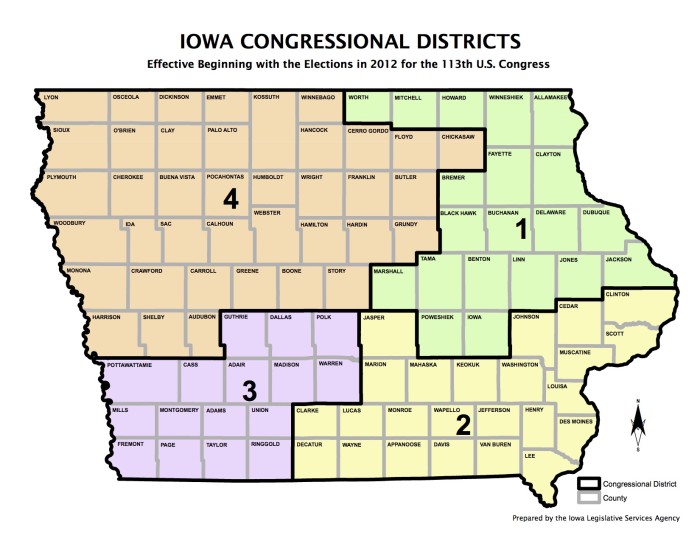The state of Iowa is not at risk of losing a seat in the U.S. House after the 2020 census, according to new projections by Election Data Services. Our state has lost seven Congressional districts since 1930, most recently dropping from five seats to four after the 2010 census. But the federal government’s latest population estimates do not put Iowa among the ten states (mostly in the Midwest or Rust Belt) likely to lose a seat during the next round of redistricting.
Of those ten states, only Illinois and West Virginia lost population between July 2016 and July 2017, according to U.S. Census Bureau data (see map enclosed below). While the other states are gaining population slowly, they are not growing fast enough to keep their per-district population in line with that of other states.
Appendices to the Election Data Services report show the projected population size of each state’s House districts after the 2020 census. In those scenarios, Iowa would have either the seventh-largest or ninth-largest districts in the country. Our state’s current estimated population is 3,145,711, which works out to 786,428 residents per district.
University of Iowa political science Professor Tim Hagle told the Cedar Rapids Gazette that Iowa “may be in line to lose a seat following the 2030 census” if our slow-growth trend continues. (Since 1930, Iowa has never gone for more than 20 years without losing a Congressional district.)
Looking at the per-district population numbers, however, several other states appear to be much closer to the edge, including neighboring Nebraska and Wisconsin. Minnesota is on the bubble to lose a seat after 2020; if it does not, that state could lose one after the next census.
Iowa’s non-partisan redistricting process is often held up as a model for the country. I have repeatedly sought comment, without success so far, on whether Governor Kim Reynolds will commit to preserving that system if she is elected to a full term in 2018. Similarly, staff for House Speaker Linda Upmeyer and Senate Majority Leader Bill Dix have ignored my inquiries about this issue. In February, House Majority Leader Chris Hagenow told me he wants to preserve our “great system” for drawing political maps, while Senate Majority Whip Charles Schneider said he will “never support” a return to gerrymandering, even if Republicans retain their legislative majorities after the next election.
Any relevant comments are welcome in this thread.



2 Comments
Two things
First, thank you for your continuing focus on Iowa’s redistricting system. I’ve read and heard several national stories that talk about how very good Iowa’s system is, compared to those in many other states. It’s horrifying to realize that our system might be politically vulnerable, but after last November, nothing feels safe anymore.
Second, is there any way to predict in advance, or have an educated guess, regarding which Iowa Congressional districts might grow or shrink in terms of numbers of counties and square miles, next time around? Or is each district likely to retain the same number of counties/miles that it has now? King’s district is geographically huge compared to the others — will that continue?
PrairieFan Sat 23 Dec 2:11 PM
good question
Most of Iowa’s counties continue to lose population, so it is likely that what constitutes the fourth Congressional district will continue to be very large geographically.
Given continuing population growth in Polk and Dallas counties, and to a lesser extent in Warren County, there seems to be a good chance that the third district will become more compact geographically after the next round of redistricting. It’s possible that the fourth district will look more like the fifth district did during the 2000s, covering all of Iowa’s westernmost counties and including Sioux City and Council Bluffs as the largest population centers.
Other than that, hard to predict what may happen. The 2000s map had Scott County in the first district and Linn County in the second district.
desmoinesdem Sat 23 Dec 4:03 PM